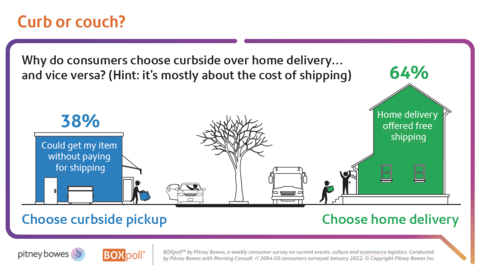<< Back
Pitney Bowes Survey: As Retailers Expand Curbside Pickup Options, 64% of Consumers Still Prefer At-Home Delivery
This press release features multimedia. View the full release here: https://www.businesswire.com/news/home/20220223005773/en/

As retailers expand curbside pickup options, 64% of consumers still prefer at-home delivery. (Graphic: Business Wire)
One of the hallmarks of the retail industry’s response to COVID-19 has been the proliferation of curbside pickup, which rose drastically from 7% in
However, at-home delivery remains king for shoppers. According to a recent BOXpoll survey, when it comes to how consumers want to collect their items, 64% prefer home delivery, while just 23% prefer curbside pickup when given a choice between the two options (12% had no opinion). The only category for which consumers preferred curbside pickup over home delivery was groceries (44% vs. 39%). In all other categories, no more than 25% of consumers preferred curbside pickup.
“While consumers like curbside pickup for time-sensitive or bulky items, our research found that nearly two-thirds of consumers will generally choose home delivery over curbside pickup, despite having to wait,” said
Baby Boomers have an especially strong preference for home delivery. Almost three-quarters of the demographic (73%) prefer delivery over curbside, and there was a 35% difference between those who are much more likely (54%) and those who are somewhat more likely (19%) to choose delivery.
The two factors that overwhelmingly drive a choice for home delivery over curbside pickup are free shipping and consumers becoming more flexible with delivery times. More than half (64%) of shoppers say that free delivery on home shipping influences their decision to use it instead of curbside pickup. Conversely, just 38% of consumers would opt for curbside pickup for online purchases (other than groceries) as a way to receive their items without paying for shipping. Thirty-seven percent of consumers would opt for curbside pickup to receive their item faster.
These findings are consistent with previous BOXpoll surveys that found nearly three-quarters of shoppers prioritize cost over delivery speed.
Understanding the significant preference toward at-home delivery over other methods,
The survey also revealed that 90% of shoppers say they will contact customer care if their online order doesn’t arrive on the date promised but will give an average grace period of 3 days before doing so. The presentation of delivery days also proved to be important to consumers. Small changes in format such as estimated number of days (“2 days”) slightly beat an estimated date (“February 24”), which is even more preferred than an estimated day of the week, like “Thursday.”
Methodology
The BOXpoll® consumer survey by
About
View source version on businesswire.com: https://www.businesswire.com/news/home/20220223005773/en/
(203) 218-1187
brett.cody@pb.com
Source:
